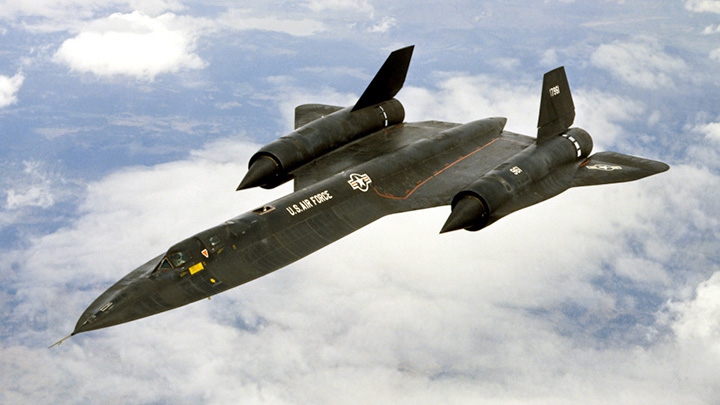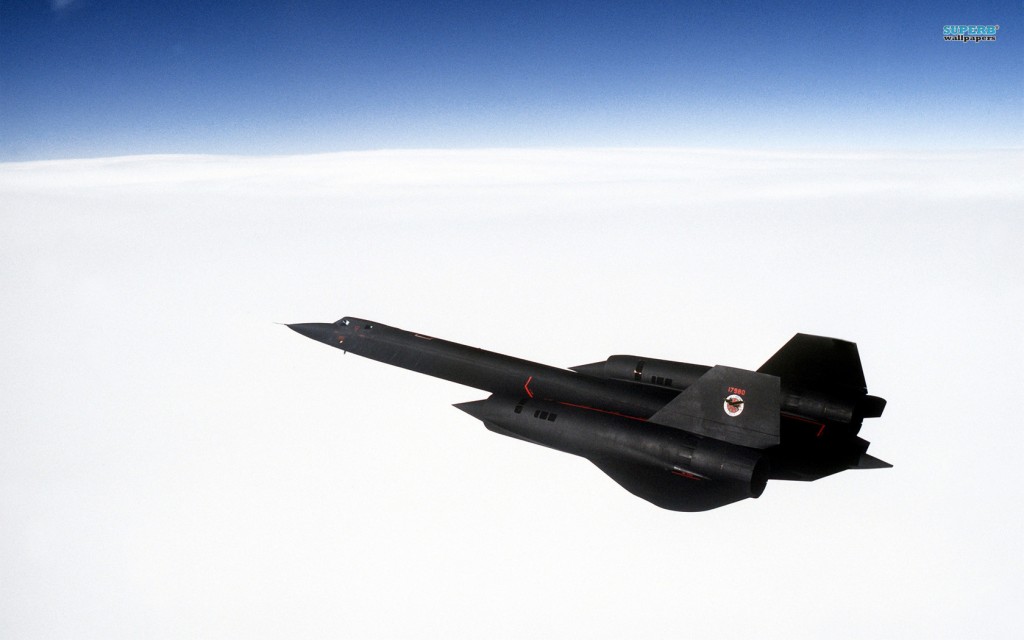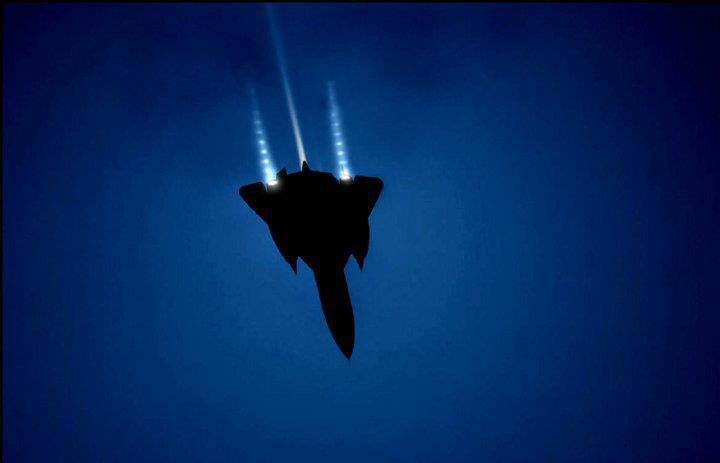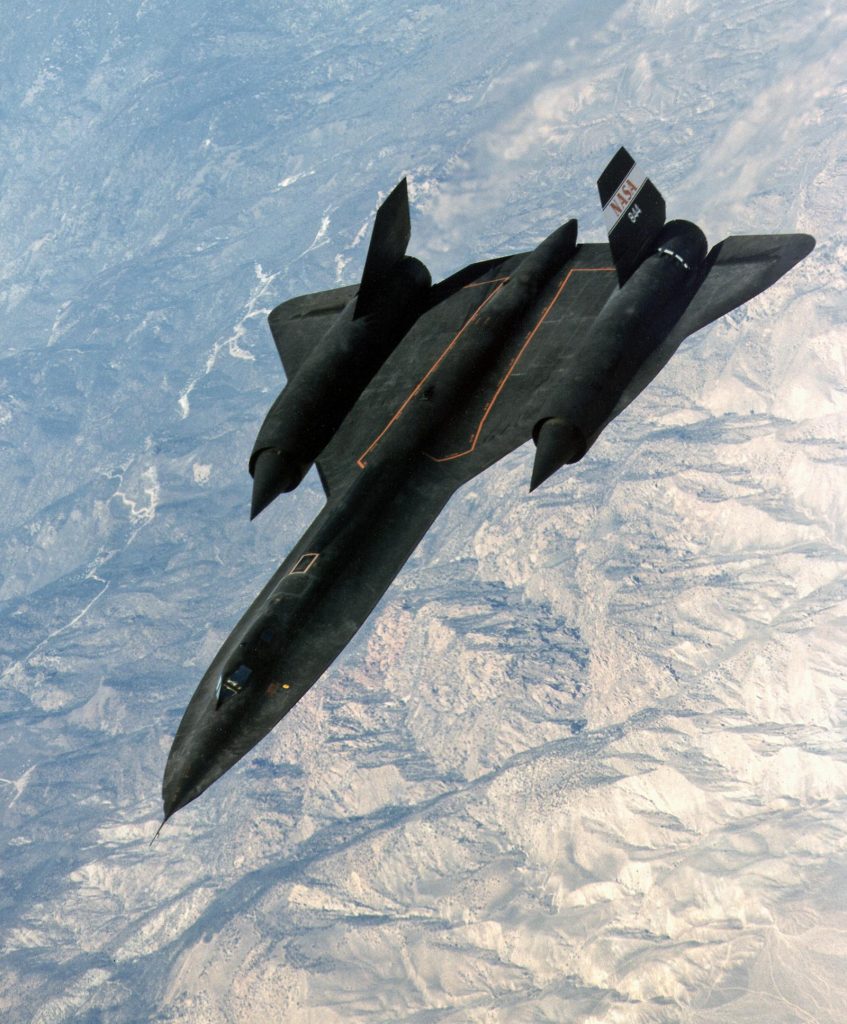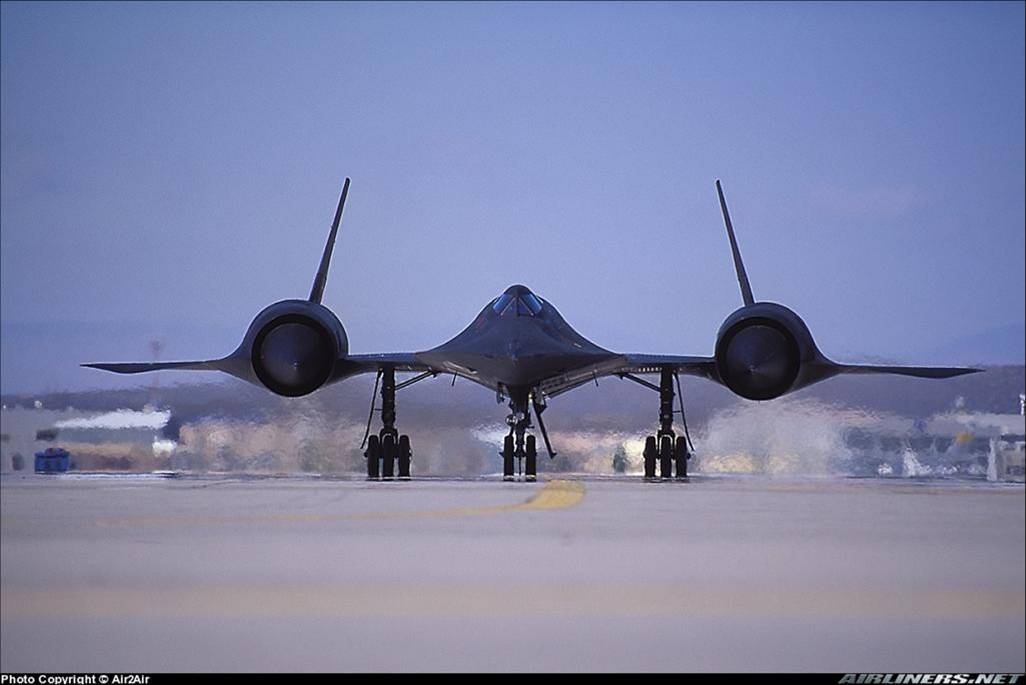Without a doubt, the SR-71 ‘Blackbird’ has to be one of the most incredible aeroplanes ever built, while at the same time being one of the most beautiful. Few aircraft invoke such a visceral sense of awe amongst aviation enthusiasts as this one does!
She was futuristic, stealthy, and with a performance more akin to a spacecraft than an atmospheric ‘air-breathing’ aircraft.
Her stated performance was impressive; however, as she was a secret ‘spy plane’, her true performance was not released until after she was retired from service. She holds the ‘official Air Speed Record for a manned air-breathing jet aircraft’ of 2,193 mph (around Mach 3.2; 3.2 times the speed of sound), set in 1976, and a reported ceiling (maximum altitude) of 80,000+ ft (which is all the US Air Force will admit to). However, on the return transatlantic flights of the Blackbirds back to the USA from their deployment bases in the UK, higher figures of 2,275mph were reported (possibly apocryphally!) and altitudes (depending on the source) of between 87,000 and 100,000ft. Of course, even the Blackbird needs sufficient air for the engines to function – it is not a rocket, after all! – and a more reasonable figure of 85,000ft as a designated maximum altitude, with inadvertent flight up to 87,000ft, has been reported, again unofficially*. And she could maintain that performance for over an hour! This is noteworthy since most supersonic aircraft (a notable exception being the Concorde) can only maintain their top speeds for a few minutes at best.
So, an aircraft steeped in mystery, but somehow even more impressive for all that.
The Blackbird, though, unlike all the aircraft I have covered so far in this series, was not an armed combat aircraft. She wasn’t made in order to bomb or shoot anything; she was a reconnaissance aircraft. She was designed to go and look at things in hostile territory, to see what is there. And in order to do that, she had to have a performance that would ensure her survival. Hence, Mach 3.2+ and above 80,000ft, for long enough to make a difference.
Whereas fast jet aircraft from the Sea Vixen to the Typhoon have been designed in more or less similar ways, essentially including the same conventional technology of other aircraft of the time, in terms of engines, aerodynamics and materials science, what made the Blackbird so special was that she was conceived in a completely different manner and using so many advances not only in technology but also in design philosophy. If you like, the aircraft was designed ‘from the ground up’ to operate in that specific performance envelope. The factor that made the similarly – performing XB-70 Valkyrie obsolete was the rapid advances in surface-to-air missile (SAM) technology, that is, missiles fired from the ground in order to shoot down their targets. The SAMs could now reach fast, high-flying aircraft, and so their threat was what forced other reconnaissance and bomber aircraft of the time to abandon the upper air altogether and rely on low-flying in order to accomplish their missions. This is why all modern air forces practice low-flying. And this is why the XB-70 was abandoned – because her incredible performance had become irrelevant.
But the Blackbird had to be designed in order to operate at such extreme altitudes and speeds, and with the range she required in order to complete her mission, because she simply had to fly high enough to be able to see what she needed to see, because she was a reconnaissance aircraft, and from higher up you can see more. Low level was not an option for the Blackbird’s mission. And so, several design factors had to be built into her from the start, in order to give her the performance she needed to survive in the SAM threat environment.
The first factor was in the Blackbird’s engines. To make things simple, I will eventually put all the technical stuff on a separate page, but basically the Blackbird’s engines were a type of hybrid engine known as a ‘turboramjet’. At high speeds, all of the thrust was provided only by the air intakes and the afterburners, and the actual jet engine in between could be, well, essentially shut down. This produced an incredibly efficient engine in terms of thrust per unit of fuel, far more efficient than the simple afterburning turbojet engine.
The next factor was of course her speed and altitude performance. Blackbird could fly higher than the XB-70, but even so, it is virtually impossible for a manned combat aircraft, even the Soviets’ MiG-25 ‘Foxbat’ interceptor, to intercept an aircraft flying that high and that fast, and then actually get into a position to shoot it down. In addition, Soviet air-to-air missiles (missiles launched from an intercepting aircraft in order to shoot down another aircraft) simply did not have the performance, at those altitudes, to be able to catch a Blackbird.
Which leaves the question of how the Blackbird managed to avoid the SAM threat, when the nearly-equally-performing XB-70 couldn’t.
The SR-71 has the (as far as I know) unique reputation that not one example of the aircraft has been lost to enemy action, even though used operationally in hostile airspace.** Even though the performance of the SR-71 is similar in many respects to that of the XB-70 Valkyrie, whose development as a manned combat aircraft was discontinued because it would have been vulnerable to interception by surface-to-air missiles (SAMs), it was still not vulnerable to SAMs as the XB-70 would have been, despite its blistering performance. This is because the SR-71 had not only powerful electronic jammers to fool hostile radars, but also an excellent combination of stealth technologies including radar-absorbent paint; radar-absorbent material wedges in the leading edges of the stabilisers, wings and fuselage; blended wing/fuselage shape and so on, which gave it the same radar visibility as a small aeroplane like the ones I fly. In other words, it looked tiny on radar.
This meant that the SAM operators would have far less time to alert their systems; in fact, not enough time for any launched SAM to get up to the Blackbird’s altitude. And the same would apply to any defending fighters, for whom their performance (and that of their missiles) would be so much inferior to that of the Blackbird that she would be long gone by the time they got up to anywhere where an air-to-air missile just might be able to bag her.
And so that was how the Blackbird managed to survive the – literally thousands – of SAMs fired at her. A combination of sustained high performance, and stealth technology which together minimised the engagement envelope of the opposing air defence system.
The end of the Cold War signified the deactivation of so much of the Western military; the Blackbirds, however, soldiered on until about 1998. There’s always a need for reconnaissance! There are two airworthy examples which are however no longer operated, but the rest are in museums. Here’s a photo of the example at the USAF museum at Duxford, UK:
And finally, here’s a lovely poetic piece expressing the sense of wonder engendered by this amazing aeroplane, by the brilliant Jeremy Clarkson:
There we are then. The amazing SR-71 Blackbird – not a Destroyer per se, but beautiful nevertheless.
For a couple of interesting anecdotes about this aeroplane, check out my previous blog posts here and here.
*However, the Blackbird’s Flight Manual, released now to the public, specified that operations above 85,000ft had to be ‘specially authorised’ (whatever that means!) and it is also apparent from that manual that the maximum airspeed depends largely on the external air temperature, in order to maintain the aircraft’s outer skin temperature within safe limits.
**Actually, now I think about it, the Vulcan was used on live combat missions into hostile airspace in the Falklands War of 1982 without losing one to enemy action; however, one was interned in neutral Brazil for nine days when it had to make an emergency landing there due to an aircraft technical fault.

